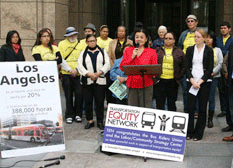
A 60 day public input period closed recently with 171 comments. And for once, the “good guys” prevailed: more backers than detractors weighed in.
Supporters include a host of transportation and civil rights advocates like the National Urban League, the Partnership for Working Families, the National Task Force on Tradeswomen, the Center for Community Change, Policylink, and Jobs to Move America. Perhaps more surprising is the support from prominent public officials and agencies like the city officials from Milwaukee and Cleveland, the Metro Transit Authority of Los Angeles and an Atlanta state senator. Even more startling is the support from labor groups, including AFSME, and the labor councils of San Mateo and San Francisco and others.
Detractors include industry types and national trades groups like the American Public Transit Association and the Associated General Contractors of Missouri.
The Gamaliel organizing network offered some very specific suggestions to improve the program:
- The opportunity for the community to weigh-in on other targeted populations (e.g., veterans).
- A community monitoring board to ensure compliance, accountability, and transparency to the citizen tax-payers.
- An incentive plan that offsets local hire implementation costs to the general contractor.
- Local hire contract provisions that create and/or expand job training and education, workforce mentoring programs, and transit connections to and from the job/project site.
- Enforcement of minority and women’s workforce participation goals: minimum goals as established by Executive Order 11246 as well as Disadvantaged Business Enterprise goals. Update minority and women’s workforce participation goals, currently at 1980 numbers, as soon as possible.
What does it mean that more than 171 organizations took time to respond to the NPRM? In the era of #Black Lives Matter, a “Local Hire” program that can move people into meaningful and well-paying careers is more important than ever to a growing number of organizations and individuals. It also means that certain players will resist change as much as possible.
Secretary Foxx has made a great opening move. His next move will show if he is ready to endure some controversy and combat institutional racism at the root.
(Photo credit: Courtesy of Gamaliel)





Comments